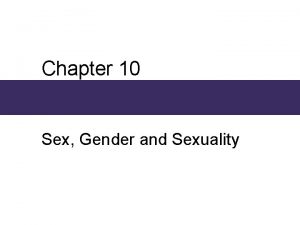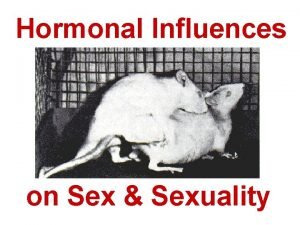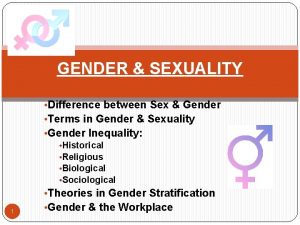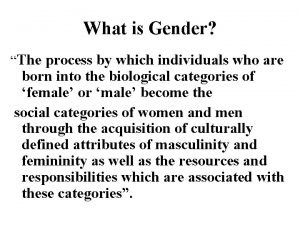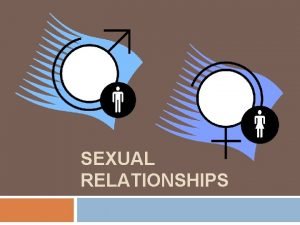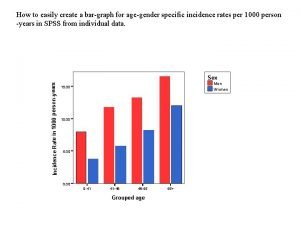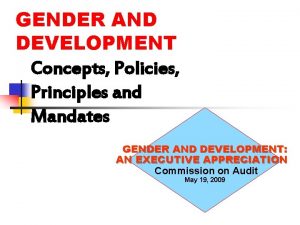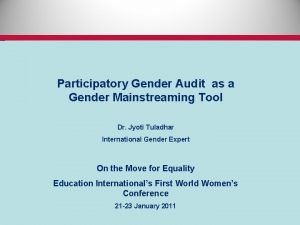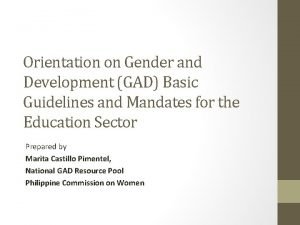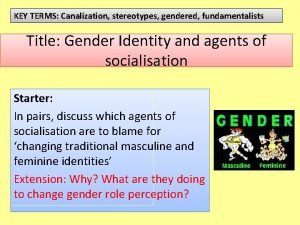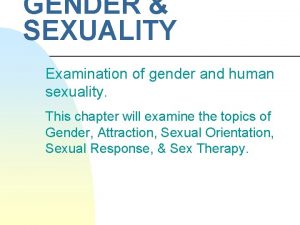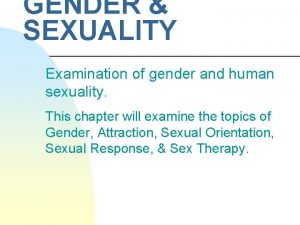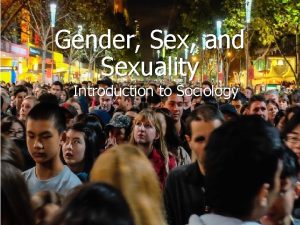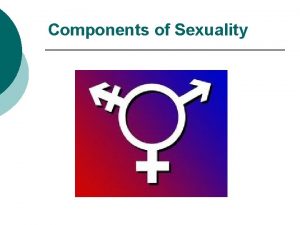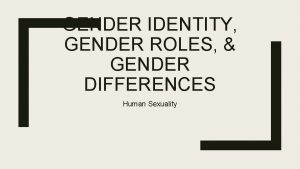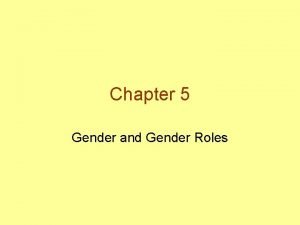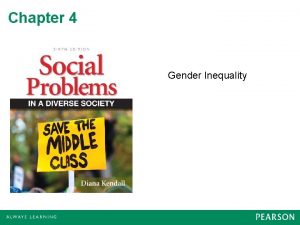GENDER SEX AND SEXUALITY CHAPTER 12 SEX VS






































































- Slides: 70

GENDER, SEX, AND SEXUALITY CHAPTER 12

SEX VS. GENDER • SEX IS THE PHYSICAL OR PHYSIOLOGICAL DIFFERENCES BETWEEN MALES AND FEMALES. • GENDER IS A PERSON’S DEEPLY HELD INTERNAL PERCEPTION OF HIS OR HER GENDER IDENTITY. • A PERSON’S SEX DETERMINED BY BIOLOGY DOESN’T ALWAYS LINE UP WITH THEIR GENDER AND THEREFORE SEX AN GENDER ARE NOT INTERCHANGEABLE.

SEX • REFERS TO THE PHYSICAL AND BIOLOGICAL • INCLUDES: • CHROMOSOMAL • XX AND XY • HORMONAL • TESTOSTERONE, ESTROGEN • AND…

SEX ANATOMICAL

GENDER AND GENDER IDENTITY • GENDER : • SOCIAL • PSYCHOLOGICAL • CULTURAL • MASCULINITY AND FEMININITY • GENDER IDENTITY : • VIEW OF HERSELF OR HIMSELF AS: • FEMININE OR MASCULINE

GENDER CHARACTERISTICS • SEX—ASCRIBED STATUS • GENDER—ACHIEVED STATUS • GENDER CHARACTERISTICS: • PHYSICAL • EMOTIONAL • BEHAVIORAL


What is considered feminine (appropriate for females) or masculine (appropriate for males) varies by culture and society

What you experience as a child plays an important and often determining factor in what you view as appropriate for your sex or for your gender

Some Native American cultures have individuals that either temporarily or permanently live as the other gender. In the past these people were called Berdache

THE SAMOAN CULTURE ACCEPTS A THIRD GENDER CALLED FA’AFAFINE – THE WAY OF THE WOMAN • THESE ARE PEOPLE WHO ARE BORN BIOLOGICALLY MALE BUT EMBODY BOTH MASCULINE AND FEMININE TRAITS. • THEY ARE CONSIDERED AN IMPORTANT PART OF SAMOAN CULTURE. • THEY ARE OFTEN MISLABELED AS HOMOSEXUAL BECAUSE OF THEIR VARIED SEXUAL LIFE THAT MAY INCLUDE BOTH MALES AND FEMALES

SEXUAL ORIENTATION • A PERSON’S SEXUAL ORIENTATION IS HIS OR HER PHYSICAL, MENTAL, EMOTIONAL, AND SEXUAL ATTRACTION TO A PARTICULAR SEX. • DIVIDED INTO 4 CATEGORIES: • HETEROSEXUALITY – ATTRACTED TO INDIVIDUALS OF THE OPPOSITE SEX (“STRAIGHT”) • HOMOSEXUALITY – ATTRACTED TO INDIVIDUALS OF THE SAME SEX (“GAY”) • BISEXUALITY – ATTRACTED TO INDIVIDUALS OF EITHER SEX • ASEXUALITY – NO ATTRACTION TO EITHER SEX The United States is considered a Heteronormative society – that is it assumes sexual orientation is biological and unambiguous

According to current science, individuals are usually aware of their sexual orientation between middle childhood and early adolescence. This has nothing to do with sexual activity, just the awareness of emotional, romantic, and physical

When it comes to “coming out” homosexual and bisexual people have very different experiences. These experiences depend greatly on geography, family, support network, personal comfort, etc. because the idea of homosexuality and bisexuality go against U. S. historical norms.

Alfred Kinsey was one of the first to say sexuality was a continuum rather than a strict gay vs. straight alignment

IN 1948 KINSEY WROTE SEXUAL BEHAVIOR OF THE HUMAN MALE WHERE HE SAID THAT MEN ARE “NOT DIVIDED INTO HETEROSEXUAL AND HOMOSEXUAL…. THE LIVING WORLD IS A CONTINUUM IN EACH AND EVERY ONE OF IT’S ASPECTS. “

Eve Kosofsky Sedgwick expanded on this by adding the term “homosocial” to oppose “homosexual. ” This refers to nonsexual same sex relationships

Sedgwick said that in U. S. culture males are subjected to a clear divide between the two sides of this continuum where females have more fluidity. For example: Women have more freedom in their homosocial feelings relationships to show their feelings like hugging, handholding, and physical closeness.

Men however avoid these things out of fear of violating the heteronormative expectations that those feelings/actions should be reserved exclusively for showing affection to females Do you know hard it Is to find homosocial images for modern men? ? ? is athletes It’s nearly impossible. Go ahead, I dare you. The closest thing you’ll find “celebrating” This is generally accepted to be because men are more subject to social disapproval for being physically close to other men.

While there is no scientific consensus regarding why a person holds the sexuality they hold, there is evidence that homosexuals and bisexuals are treated differently than heterosexuals in school, the workplace, and the military In a 2011 survey 27% of homosexual or bisexual respondents reported experiencing discrimination, 38% of openly LGB people experienced discrimination during the same 5 year period.

Much of this discrimination is based on stereotypes and misinformation as well as heterosexism (Heterosexism is an ideology and a set of institutional practices that privilege hetoersexuals and heterosexuality over homosexuals and homosexuality) What are some stereotypes about LGBTQ people? In 1996 the Defense of Marriage Act passed explicitly limiting the definition of marriage to one woman and one man and allowed states to decide whether they recognized same sex unions or not. In 2008 Prop 8 passed in California that limited marriage to opposite sex partners.

Homophobia: an extreme or irrational fear or aversion to homo

2010: Prop 8 was found unconstitutional 2011: Don’t Ask/Don’t Tell overturned 2013 Windsor v. United states overturned part of DOMA 2014: U. S. Supreme Court refused to hear appeals to rulings against same sex union bans (Means that the bans were overturned) Employee Non-Discrimination Act is still pending

Gender Identity To some extent, people can assume the roles not normally associated with their gender without any interference with their gender identity. However, people who identify with the role that is different from their biological sex are called Transgender.

Transgender is NOT the same as homosexual. Many homosexual men, for example, identify both their sex and gender as male. Transgender people who use medical intervention such as surgery or hormonal replacement to help their physical being be better aligned with their gender identity are called transsexuals. For many years, Gender Identity Disorder was listed in the APA DSM for mental disorders. It has since been replaced by the term Gender Dysphoria which says that a person has a birth gender that is contrary to what they identify as.

Gender and Socialization

Children learn at a young age that there are distinct expectations for boys and girls. Generally children are aware of gender roles by age 2 or 3 and by 4 or 5 children are firmly entrenched in culturally appropriate gender roles


Gender Roles: Who does What? Cooking? Nurse? Soldier? Lawyer? Changing diapers ? Elementary School Teacher ? Fishing? Fixing stuff? Wears blue? Violent? Angry? Irrational? Submissive? No Emotions? Emotional? Cleaning the house? Doctor? Airline Pilot? Raising the kids? Being the bread winner? Hunting? Better Driver? Mechanic? Wears pink? Peaceful? Calm? Dominant? Emotional? Aggressive? Never Cries?

SOCIAL CONSTRUCTION OF GENDER • GENDER ROLES – Expectations regarding proper: – Behavior – Attitudes • LITTLE GIRL COMMENTS ON GENDER – Activities ROLES: – Roles in work – Reaction to others – Clothes – Toys – Etc.

This gender socialization usually starts at birth

These norms are based on norms created by society and in U. S. culture masculine roles are usually associated with strength, aggression, and dominance while feminine roles are usually associated with passivity, nurturing, and submission. Studies show that children will often choose “gender appropriate” toys even when cross-gender toys are available because of the feedback that children get for gender normative behavior

The drive to stick with traditional gender roles continues as a person grows into adulthood. Men tend to outnumber women in “aggressive” jobs like police, military, and politics Women tend to outnumber men in care related jobs like health-care, education, and social work This just reflects a fulfilment of societal expectations NOT one of personal choice.

Even when parents try to promote gender equality there are often underlying inequalities (Chores, curfew, dress codes, general behavioral expectations, etc). Boys are more attuned to their father’s disapproval when acting outside of gender expectations. Even race plays a role; African American families are more likely than Caucasian families to model an egalitarian family structure

Gender Socialization in School Studies suggest that socialization still happens in schools. In a 1994 study of Kindergartens by Sadker and Sadker, data showed that teachers praised male students far more than female students. Teachers were also more likely to interrupt girls or give boys more options to expand on their ideas) Studies also show that boys are more likely to get away with bad behavior than girls. (Think dress code, horsing around, etc. ) “Boys will be Boys” afterall…



Advertisements (both print and TV) are probably the biggest offenders There are two main themes here: Women – good for cooking, cleaning, and sex (Oh, and don’t be fat!) Men – incapable of simple household chores, must be “manly, ” (And don’t be fat! Have muscles like Schwarzenegger in his prime)



Social Stratification and Inequality Stratification is a system where groups of people experience unequal access to basic yet valuable societal resources. In the US, stratification is experienced by gender, race, income, occupation, etc. Gender stratification is especially noticeable in the area of economics. Women make up 49. 8% of the work force but are underrepresented in positions of power and authority, women also do the majority of unpaid household work, and make 77¢ for every $1 that a man makes.

This isn’t just a US thing however, all societies classify work by gender, it is a cultural universal, however, the specifics of that work are NOT universal. According to George Murdock, men’s work is given more prestige then women’s work regardless of what that work actually is. Women’s rights have come a long way (though they do have a long way to go) 1809 – Women can now make a will 1840 – Women can finally own and control property 1920 – Women can vote 1963 – Employers now have to pay women the same for the same work (still $. 77/dollar)

Theoretical Perspectives on Gender








Sex and Sexuality

In the area of sexuality, sociologists focus on sexual attitudes and practices, not on physiology or anatomy. Sexuality is viewed as a person’s capacity for sexual feelings. Sexual activity is a Cultural Universal HOWEVER sexual behaviors and how they’re viewed are culturally unique. (There are some exceptions, for example incest is taboo everywhere, but which relative that means fluctuates by society. )

What is considered normal in terms of sexual behavior is based on the mores and values of the society. People are socialized to those mores by family, school, peers, media, and most influential historically – Religion. Recently, peers and media have become more important to U. S. teens.


Example: Men are expected to have, or have the right to, more sexual urges than women. When a man has multiple partners he’s often celebrated. When a woman does she’s a slut. Premarital sex is accepted and expected of men whether or not they’re in a committed relationship. Premarital sex is generally frowned on for women unless they’re in a committed relationship. This means that most women at 35 will have had about 3 sexual partners while a man will have had at least 6. (CDC

Young people’s views on sex are changing, which means that as a society the U. S. views on sex and sexuality will change with them: 1. More young people think it’s acceptable for a single woman to have a child 2. More young people agree that waiting until marriage for sex is a “nice idea” but not realistic However, most college age people (male 98. 9% & females 99. 2%) want to end up in a mutually exclusive sexual relationship with one partner in their lives (traditional, monogamous, marriage. )

Sex Ed





Sociological perspectives on sex and sexuality





From a economic perspective, activists point out that legal marriage brings certain financial benefits like social security benefits, and medical insurance. Denial of these benefits because of sexual orientation is wrong. Conflict theory says as long as heterosexuals and homosexuals struggle over this, there will be conflict.



 Chapter 10 sex gender and sexuality
Chapter 10 sex gender and sexuality Sex gender and sexuality
Sex gender and sexuality Umbrella term
Umbrella term Sex sex sex
Sex sex sex Sex in the greenhouse
Sex in the greenhouse Sex sex sex
Sex sex sex Sex sex sex
Sex sex sex Secondary sexual characters
Secondary sexual characters Strategic gender needs and practical gender needs
Strategic gender needs and practical gender needs Gender and sex difference
Gender and sex difference Gender and sex difference
Gender and sex difference Difference between sex and gender
Difference between sex and gender Sex vs gender essay video
Sex vs gender essay video Pretest growth development and sexuality
Pretest growth development and sexuality X linked punnett square
X linked punnett square Advanced higher biology unit 2
Advanced higher biology unit 2 Sex determination and sex linkage
Sex determination and sex linkage Sexuality in advertising
Sexuality in advertising What are the 4 strands of sexuality
What are the 4 strands of sexuality Awareness, acceptance and comfort with one’s own body
Awareness, acceptance and comfort with one’s own body Definition of sexuality
Definition of sexuality Types of sexual relationships
Types of sexual relationships Which illustrates an emotional aspect of teen sexuality?
Which illustrates an emotional aspect of teen sexuality? Peer sexuality support programme
Peer sexuality support programme Base of uterus
Base of uterus Sexuality spectrum
Sexuality spectrum Once a sex offender always a sex offender
Once a sex offender always a sex offender Chapter 11 gender age and health review worksheet answers
Chapter 11 gender age and health review worksheet answers Deborah tannen difference theory
Deborah tannen difference theory Snow white 1812
Snow white 1812 Gender-neutral housing pros and cons
Gender-neutral housing pros and cons Performative acts and gender constitution judith butler
Performative acts and gender constitution judith butler Gender and interpersonal communication
Gender and interpersonal communication Gender graph
Gender graph Development of gender roles
Development of gender roles Gad objectives
Gad objectives Social stratification in gender
Social stratification in gender Objectives of gender and development
Objectives of gender and development Female deficit model example
Female deficit model example Evaluation schema
Evaluation schema Dynamic approach language and gender
Dynamic approach language and gender Centre for gender diversity and inclusion statistics
Centre for gender diversity and inclusion statistics What is the study of communication, gender and culture
What is the study of communication, gender and culture Ap psychology sexual motivation
Ap psychology sexual motivation Integration of gender roles in school and curriculum
Integration of gender roles in school and curriculum Centre for gender diversity and inclusion statistics
Centre for gender diversity and inclusion statistics Martin and halverson 1983
Martin and halverson 1983 Language and gender
Language and gender Gender and development
Gender and development Sample lesson plan in gender and development
Sample lesson plan in gender and development Blood pressure chart by age and gender
Blood pressure chart by age and gender Gender based violence
Gender based violence Punnett square xy
Punnett square xy Xxy gender
Xxy gender Gender action plan world bank
Gender action plan world bank Gender action plan world bank
Gender action plan world bank Difference between wid, wad and gad concepts
Difference between wid, wad and gad concepts Unesco
Unesco Slidetodoc.com
Slidetodoc.com Define gender constancy
Define gender constancy It is a lifelong process of social interaction
It is a lifelong process of social interaction Gender definition
Gender definition Xxy chromosome gender
Xxy chromosome gender Explain sex determination
Explain sex determination Moser gender planning framework
Moser gender planning framework Is there any bias in gender roles based on the excerpt
Is there any bias in gender roles based on the excerpt Tt x tt punnett square
Tt x tt punnett square Paradigm shift from women studies to gender studies
Paradigm shift from women studies to gender studies Mbti by gender
Mbti by gender Canalization gender examples
Canalization gender examples Gender criticism in literature
Gender criticism in literature
